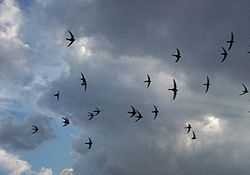Apus (genus)
| Apus | |
|---|---|
 | |
| Common Swifts (Apus apus) | |
| Scientific classification | |
| Kingdom: | Animalia |
| Phylum: | Chordata |
| Class: | Aves |
| Order: | Apodiformes |
| Family: | Apodidae |
| Genus: | Apus Scopoli, 1777 |
| Species | |
|
About 17, see list | |
They are among the fastest birds in the world. They resemble swallows, to which they are not related, but have shorter tails and sickle-shaped wings. Swifts spend most of their life aloft, have very short legs and use them mostly to cling to surfaces.
Taxonomic history of Apus
Before the 1950s, there was some controversy over which group of organism should have the genus name Apus.[1] In 1801 Bosc gave the small crustacean organisms known today as Triops the genus name Apus, and later authors continued to use this term. Keilhack suggested (in 1909) that this was incorrect since there was already an avian genus named Apus by Scopoli in 1777 . It wasn't until 1958 when the International Commission on Zoological Nomenclature (ICZN) ruled against the use of the genus name Apus and instead recognized the term Triops that the controversy finally ended.
Systematics
- Cape Verde Swift, Apus alexandri
- Common Swift, Apus apus
- Plain Swift, Apus unicolor
- Nyanza Swift, Apus niansae
- Pallid Swift, Apus pallidus
- African Black Swift, Apus barbatus
- Forbes-Watson's Swift, Apus berliozi
- Bradfield's Swift, Apus bradfieldi
- Malagasy Black Swift, Apus balstoni
- Pacific Swift, Apus pacificus
- Salim Ali's Swift, Apus salimalii
- Blyth's Swift, Apus leuconyx
- Cook's Swift, Apus cooki
- Dark-rumped Swift, Apus acuticauda
- Little Swift, Apus affinis
- House Swift, Apus nipalensis
- Horus Swift, Apus horus
- White-rumped Swift, Apus caffer
- Bates's Swift Apus batesi
- Fernando Po Swift Apus sladeniae
Known fossil species are:
- Apus gaillardi (Middle/Late Miocene of La Grive-St.-Alban, France)
- Apus wetmorei (Early - Late Pliocene? of SC and SE Europe)
- Apus baranensis (Late Pliocene of SE Europe)
- Apus submelba (Middle Pleistocene of Slovakia)
The Miocene "Apus" ignotus is now placed in Procypseloides.
References
- ↑ O. S. Møller, J. Olesen, and J. T. Høeg (2003). "SEM studies on the early larval development of Triops crancriformis (Bosc)(Crustacea: Branchiopoda, Notostraca)". Acta Zoologica 84: 267–284. doi:10.1046/j.1463-6395.2003.00146.x.
- Chantler, Phil & Driessens, Gerald (2000): Swifts : a guide to the swifts and treeswifts of the world. Pica Press, Mountfield, East Sussex. ISBN 1-873403-83-6